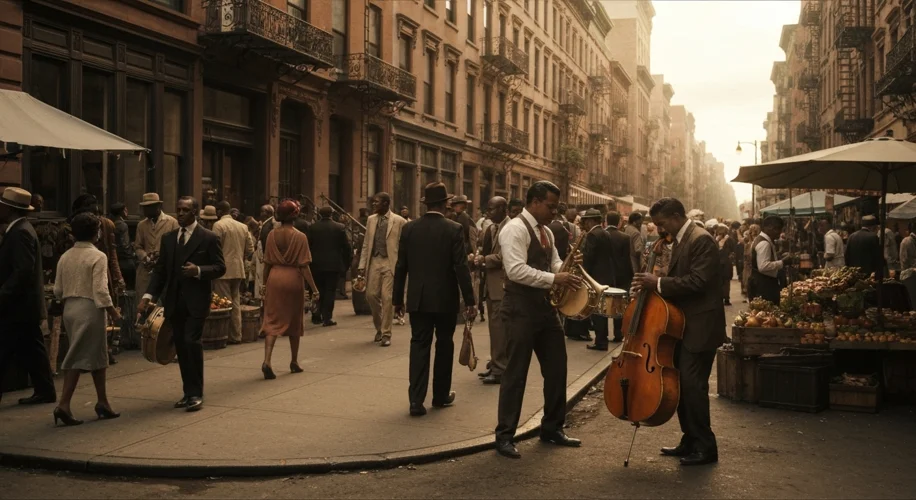The air in Harlem, New York, crackled with an energy unlike any other in the early 20th century. It was a time of burgeoning hope, artistic fervor, and a profound reawakening of Black identity. From the 1920s onward, this vibrant neighborhood became the epicenter of an intellectual, social, and artistic explosion that would echo through American history and beyond – the Harlem Renaissance.
Imagine the scene: the smoky haze of jazz clubs throbbing with the syncopated rhythms of Louis Armstrong, the intellectual debates spilling out of salons, and the vivid colors of new paintings adorning gallery walls. This wasn’t just an artistic movement; it was a cultural revolution, a defiant declaration of Black excellence in the face of pervasive racism and discrimination.

A Seed Planted in Fertile Ground
The roots of the Harlem Renaissance lay in the Great Migration, a mass exodus of African Americans from the rural South to Northern cities. Seeking economic opportunities and fleeing the brutal Jim Crow South, hundreds of thousands of Black Americans converged on urban centers, with Harlem emerging as a major destination. By the 1920s, it had become the largest Black community in the world, a burgeoning mecca where shared experiences and a collective desire for self-determination fostered an unprecedented cultural flowering.
This was a generation that had witnessed the horrors of World War I, a war fought for democracy abroad while enduring systemic inequality at home. This tension, coupled with the growing influence of Black intellectuals and activists, fueled a powerful urge to define Black identity on their own terms, free from the stereotypes and oppressions of the past. The prevailing sentiment was a desire to showcase the richness and complexity of Black life, art, and thought to a world that had long overlooked or willfully ignored it.
The Titans of the Renaissance
The Harlem Renaissance was a constellation of brilliant minds and artistic talents. Poets like Langston Hughes, with his evocative verses capturing the soul of Black America, and Claude McKay, whose fiery sonnets spoke of defiance and pride, became the voices of a generation. Hughes, in particular, sought to capture the everyday experiences and vernacular of Black life, famously stating, “I, too, sing America.” His poem “The Negro Speaks of Rivers” beautifully articulated a deep, ancestral connection to history and identity.
Zora Neale Hurston, a pioneering anthropologist and novelist, delved into the folklore and dialects of Black communities, bringing their stories to life with unparalleled vibrancy in works like “Their Eyes Were Watching God.” Her anthropological work also provided crucial documentation of Black oral traditions.

In the realm of music, the infectious sounds of jazz and blues poured from Harlem’s clubs. Duke Ellington, with his sophisticated arrangements and innovative compositions, transformed jazz into a respected art form. Louis Armstrong’s virtuosic trumpet playing and charismatic stage presence captivated audiences, while Bessie Smith, the “Empress of the Blues,” poured her heart into every note, her powerful voice resonating with raw emotion.
The visual arts also flourished. Artists like Aaron Douglas, whose distinctive style blended African motifs with modernism, created powerful murals and illustrations that adorned books and public spaces. Jacob Lawrence, later in his career but deeply influenced by the Renaissance spirit, would go on to depict the Great Migration with his iconic “Migration Series.”
A Tapestry of Expression
The movement wasn’t monolithic; it encompassed a diverse range of perspectives and artistic styles. Some artists focused on celebrating Black heritage and history, others on critiquing racial injustice, and still others on exploring the complexities of urban life and identity. This internal dialogue and multiplicity of voices were crucial to the Renaissance’s dynamism.
The literary magazine “The Crisis,” published by the NAACP and edited by W.E.B. Du Bois, and “Opportunity: A Journal of Negro Life,” published by the National Urban League, served as vital platforms for emerging Black writers and artists, fostering a sense of community and providing critical avenues for publication and recognition.

The Renaissance also saw a burgeoning of Black theater, with playwrights and actors pushing the boundaries of representation and storytelling. Plays exploring Black history, social issues, and everyday life began to gain traction, challenging the minstrelsy stereotypes that had long dominated the stage.
The Lasting Echoes
The Harlem Renaissance, though primarily concentrated in the 1920s, had a profound and lasting impact. It laid the groundwork for future Black artistic and intellectual movements, proving that Black artists could produce work of world-class caliber. It challenged racist stereotypes, fostered a sense of racial pride and consciousness, and significantly contributed to the broader American cultural landscape.
While the Great Depression and World War II brought an end to the intense period of cultural output, the seeds sown in Harlem continued to grow. The Renaissance instilled a belief in the power of art as a tool for social change and self-definition, influencing generations of Black artists, writers, musicians, and thinkers. It remains a testament to the resilience, creativity, and enduring spirit of African Americans, a vibrant chapter in the American story that continues to inspire and resonate today.
The echoes of the Harlem Renaissance can be heard in the music, literature, art, and activism that continue to shape our world, a powerful reminder of a time when a community found its voice and proclaimed its brilliance to the globe.

